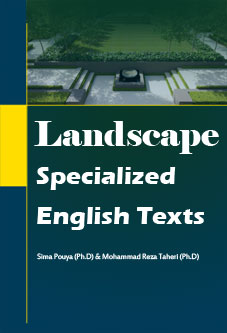
Landscape Specialized English Texts
Nowadays, English language is the common language among researchers. New findings in each scientific domain are typically published in English. Furthermore, articles presented in international conferences or published in scientific journals, valid university textbooks, scientific data and documents, etc. might attract more audience when published in English language. That is why most of researchers and authors regard English language as priority in their manuscripts.
Students and researchers of different scientific domains should not only be familiar with English language, but also they need to know about their technical texts so that they would be able to make use of the wide sources published in English language and make a more efficient relationship with the borderless scientific world.
The "Landscape Specialized English Texts" has been regarded as a scientific source for three fields of green space engineering, environmental desig, and architecture. The main purpose of compiling and preparing this book is both familiarizing readers with technical and common terms and also enhancing their skills to comprehend the scientific texts of the above-mentioned fields. To achieve the purpose, it includes main topics such as: principles of desig, ornamental trees, history of architecture and green space engineering, park designing, lawning, flowering, apartment plants, green space management, urban space designing, special parks and areas designing, use of computer in green space, etc.
The texts of each lesson were selected from sources whose authors were native in English. In this way, this book helps the readers with some background information about specific topics besides improving their knowldge of English. Moreover, a variety of exercises has been considered for each lesson to make the comprehensive understanding of the texts. Although different texts have been selected for the book, the wide nature of this domain makes it possible to add further texts with different issues in next editions of the book.
Since no textbook and scientific writings might be found that are immaculate, all students, professors, and colleagues are deeply requested to share their valuable standpoints with the authors of the book.
In the end, the authors of the book would like to express their deepest gratitude to Mr. Derakhshan, manager of Ideh Derakhshan publications, for his cooperation and the opportunity that he provided for us to publish the book. The authors also thank Mr. Aghlmand for providing us with constructive comments and also preparing a channel to offer and sell the book internationally.